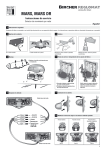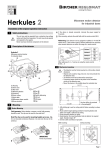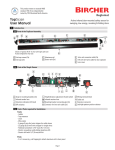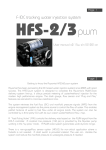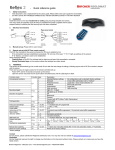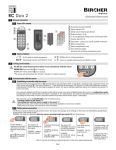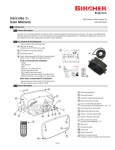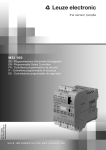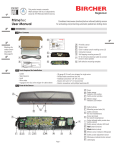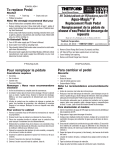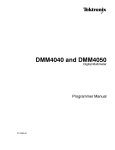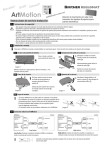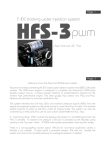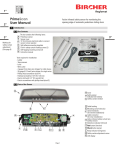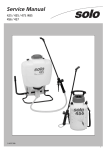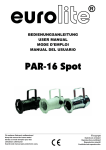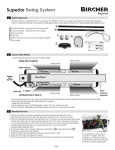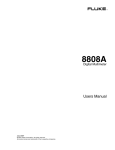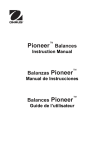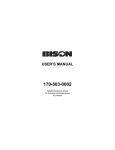Transcript
Instruction manual ESD3 switching units Blockschema und Anschlussbelegung 6 9 Gehäuse Schutzart Schutzart Einsatzort Gewicht Spannungsversorgung nach EN60204-1 (typenabhängig) Frequenzbereich Leistungsaufnahme Einschaltdauer Befestigung 12 Signalgeber 1 1 2 Signalgeber 2 3 4 13 15 5 6 * 16 7 8 9 10 Klemme 1 2 3 4 5 6 7 8 Klemme 9 10 11 12 13 14 15 16 Signalgeber 1 Signalgeber 1 Signalgeber 2 Signalgeber 2 externer Reset externer Reset Melderelais Melderelais Sicherheitsausgangs-Relais Gebrauchskategorie nach EN60947-4-1** Speise-Spannung Speise-Spannung – Sicherheitsausgang 1 Sicherheitsausgang 1 – Sicherheitsausgang 2 Sicherheitsausgang 2 Gebrauchskategorie nach EN60947-5-1** (DC13: 6 Schaltspiele/Min.) Kontaktabsicherung nach EN60947-5-1 Kontakte Lebensdauer *Bei Versionen mit automatischem Reset ist dieser in der Schaltung integriert Beschaltung 7 P 12 1 2 Signalgeber 1 Signalgeber 2 * Melderelais Schaltvermögen** 13 15 3 4 16 5 6 Anzeigen Betrieb Störung Sicherheitsabschaltung 7 8 9 Technische Daten M 10 1 DIN ABS, rot/schwarz IP30 (IEC 529) IP54 max. 250 g (typenabhängig) 24 VACDC ±10% 115 VAC ±10% 230 VAC ±10% 50/60 Hz (45–66 Hz) max. 5 VA 100% ED Hutschiene 35 mm nach EN 50022 AC-1: 250V/2A/500VA ca. 300’000 Schaltspiele DC-1: 24V/2A/48W ca. 700’000 Schaltspiele AC-15: 250V/2A/500VA ca. 130’000 Schaltspiele DC-13: 24V/2A/48W ca. 70’000 Schaltspiele 2 A träge 2.2 Safety Instructions • The assembly, commissioning, modifications and extensions may only be completed by an experienced electrician! • Before commencing work remove the power supply from the units/installations! • During the operation of electrical components – components are connected with dangerous voltages – e. g. in the case of a short circuit hot and ionised gases can be emmited – protection covers are not to be removed! • Pay attention to all local relevant electrical safety regulations! • Disregard of the safety regulations can cause death, severe injuries or extensive damage! • Keep the these operating instructions in a safe place for later use! Before commencing the installation or assembly complete the following safety precautions: • Check the voltage data on the type plate of the switching unit. • Remove the power supply from the units/installation! • Ensure that the units/installations can not be switched on! • Determine that the power supply is disconnected! • Ground the phases and short circuit! • Separate or cover neighbouring components which are connected to the power supply! • Cover the unit during assembly! Foreign particles (e.g. borings from drilling) can the damage the unit. • Protect the unit with a housing against contamination or aggressive environments! Limited protection against accidental contact! zwangsgeführte Relais, AgCuNi mech. 50 Mio. Schaltspiele 2 Product Description ESD3 switching units are used for monitoring pressure sensitive protective devices from Bircher Reglomat AG (for contact mats acc. to EN 1760-1, for safety edges acc. to EN 1760-2). They meet the requirements of standard EN 954-1 for protective equipment up to safety category 3, if the drive is directly connected to the ESD3. 24VDC/1A, resistive Last 30VAC/1 A, resistive Last grün rot (Signalgeber-/Systemstörung) gelb (Signalgeber) The ESD3 is fail-safe (single fault) and has two input channels with redundant evaluation. Each channel controls a positively driven relay. During each switching operation, the relays test themselves by means of contact feedback. N Ansprechzeit Sicherheitsausgangs-Relais Anschlussbeispiel für einphasigen Antrieb ohne Hilfsschütz 45 < 50 ms F2–4 1 2 Signalgeber 1 Signalgeber 2 13 15 3 4 * 5 6 9 Maschinensteuerung 16 7 1) Funzione ión Func Für die 24 VACDC-Speisung muss die Versorgung aus einem Sicherheitstrafo nach IEC 742 erzeugt werden. Die Leitungsverlegung muss geschützt vor mechanischen Beschädigungen erfolgen. When one or more sensors are activated • the total resistance of the activated sensor system sinks towards zero ohm • the value falls below the defined threshold • the “safety” relay is de-energised • the yellow LED’s illuminate 3 yd Sk tiv ak el arf Giv 1) 10 K2 Weitere Angaben zum Einsatz eines ESD3-Schaltgerätes mit Schaltmatten oder -leisten als Sicherheitssystem entnehmen Sie bitte aus der Benutzerinformation (auf Anfrage bei einer unserer Vertriebsstellen erhältlich). M 3 N Anschlussbeispiel für dreiphasigen Antrieb mit Hilfsschützen 1) K1 und K2 müssen so ausgelegt sein, dass das Verschweissen der Kontakte sicher durch K1 und K2 erkannt wird und nicht zum Verlust der Sicherheit führt Wartung und Fehlersuche Nach korrekter Montage und Installation und bei Beachtung der technischen Daten arbeitet das Gerät wartungsfrei. Die korrekte Funktion des Sicherheitssystems muss jedoch periodisch (monatlich, oder nach übergeordneten Vorschriften) geprüft werden. Dabei sind auch die Signalgeber und Zuleitungen auf mechanische Beschädigungen zu kontrollieren. Ist die Funktionalität nach Verdrahtung gemäss Schaltplan nicht gewährleistet und leuchten beide gelben bzw. roten LEDs, gehen Sie folgendermassen vor: 1. Reset-Taste drücken (min. 1 Sek.) 2. Sämtliche Signalgeber auf Betätigung oder Beschädigung überprüfen 3. Signalgeber-Widerstände an Klemmen 1/2 und 3/4 prüfen (8.2 kOhm) 4. Erneute Inbetriebnahme Leuchten danach immer noch beide roten LEDs, so liegt eine Gerätestörung vor. Gerät zurück zur Kontrolle. Leuchtet nur eine gelbe bzw. rote LED Gerät zurück zur Kontrolle. 10 Gewährleistung und Haftung 1. Die Gewährleistung und Haftung der Bircher Reglomat AG richten sich nach dem Kaufvertrag. 2. Die Gewährleistung und Haftung erlischt vorzeitig, wenn der Kunde oder Dritte das Produkt nicht gemäss der vorliegenden Betriebsanleitung einsetzen und/oder bedienen, der Kunde oder Dritte unsachgemässe Änderungen oder Reparaturen vornehmen, der Kunde oder Dritte, falls ein Mangel aufgetreten ist, nicht umgehend alle geeigneten Massnahmen zur Schadensminderung treffen und der Bircher Reglomat AG Gelegenheit geben, den Mangel zu beheben. 3. Von der Gewährleistung und Haftung ausgeschlossen sind Schäden, die nicht nachweisbar infolge schlechten Materials, fehlerhafter Konstruktion oder mangelhafter Ausführung entstanden sind sowie Schäden, die aus anderen Gründen entstanden sind, welche die Bircher Reglomat AG nicht zu vertreten hat. 4. Eine Haftung für Folgeschäden ist ausgeschlossen, soweit zwingende produktehaftpflichtrechtliche Bestimmungen dem nicht entgegenstehen. 5. Die Gewährleistungsansprüche aus dem Kaufvertrag gegenüber dem Händler werden durch diese Bestimmungen nicht berührt. 6. Bircher Reglomat AG entwickelt ihre Produkte zum Nutzen ihrer Kunden stetig weiter. Bircher Reglomat AG behält sich das Recht vor, ohne vorherige Ankündigung, an jedem in dieser Dokumentation erwähnten Produkt, Änderungen vorzunehmen. Bircher Reglomat AG, Wiesengasse 20, CH-8222 Beringen, Tel. +41(0)52 687 11 11, Fax +41(0)52 687 11 12 Änderungen vorbehallten Sensor 2 3 4 13 15 5 6 16 7 8 Terminal 1 2 3 4 5 6 7 8 Terminal 9 10 11 12 13 14 15 16 Signal Sensor 1 Signal Sensor 1 Signal Sensor 2 Signal Sensor 2 External Reset External Reset Status Relay Status Relay Supply Voltage Supply Voltage – Safety Output Relay 1 Safety Output Relay 1 – Safety Output Relay 2 Safety Output Relay 2 Safety Output Relay Utilization category acc.to EN60947-4-1** Utilization category acc.to EN60947-5-1** (DC13: 6 switchings/ minute) Contacts Operating Life Fuse Protection acc. to EN60947-5-1 *Versions with automatic reset have this function integrated in the circuit Commissioning • It is recommended that the resistance of the sensor is measured on the terminals 1 and 2 as well as 3 and 4. This should be between 7.5 and 9.0 kOhm with a non-activated sensor (typical 8.2 kOhm) • Check that the power supply is in accordance with the value indicated on the type plate of the unit • If one or more sensors are activated both yellow LED’s “Safety Function” illuminate and both signal output relay de-enegise. The sensors must now be activated at various positions whereby both yellow LED’s must illuminate each time. The signal output relays remain de-energised • Push the external reset button (ESD3-05/05C/06/09), minimum 1 second. • If a terminal of the sensor input (e.g. 1) opened and the sensor connection is disconnected the sensor output relays will de-energise and the red LED’s “System Error” illuminate. The fault indicator contact opens (respectively closes with ESD3...C) • If the terminal is subsequently closed the fault condition remains until the external reset button is pressed (ESD3-05/05C/06/09), or the power supply is disconnected for a few seconds Control of External Contactors 7 P 12 Sensor 1 1 2 Sensor 2 3 4 * Status Relay Switching Capacity** 13 15 16 5 6 7 8 9 M 10 4 DIN ABS, red/black IP30 (IEC 529) IP54 max. 250 gramm (depending on type) 24 VACDC ±10% 115 VAC ±10% 230 VAC ±10% 50/60 Hz (45–66 Hz) max. 5 VA 100% 35 mm mounting rail acc. to EN 50022 AC-1: 250 V/2 A/500 VA approx. 300’000 switchings DC-1: 24 V/2 A/48 W approx. 700’000 switchings AC-15: 250 V/2 A/500 VA approx. 130’000 switchings DC-13: 24 V/2 A/48 W approx. 70’000 switchings positively driven relays, AgCuNi mechanical 50 million switchings 2 A slow 24VDC/1A, resistive load 30VAC/1 A, resistive load Indicators Operation Error Safety Switch-off Green Red (sensor resp. system error) Yellow (sensor) Reaction Time Safety Output Relay < 50 ms Temperature Range Operation Storage Humidity –20°C to +55°C –20°C to +80°C max. 80% relative (no condensation allowed) N Wiring example for a one phase drive without control relay F1 Assembly and Removal L1 L2 L3 12 A E 1 Sensor 1 1 2 Sensor 2 3 4 Serv ice Po we Commutazione Arrê r di sicurezza sé t de S curité ia Stoafety p AnomaliaDDé 3 raESD3 S ng Se l periferica 3 E détecteuEem en n de t rrro sor Fallo or SD r ESD sens E 3 2 senc re k ds 1 2 Technical data Housing Isolation Class Protection Class Weight Power Supply acc. to EN60204-1 (depending on type) Frequency Range Power consumption Duty Cycle Fastening 9 10 The switching unit is reset as follows • by pressing an external reset button (ESD3-05/05C/06/09) external reset, • as soon as the sensor is no longer actuated (ESD3-03/03C/04/08) auto reset, • when the electrical power supply is interrupted. The recovery time is < 1 sec., then the green LED lights up. Pre ts ft Dri Sensor 1 * When an Error occurs in the sensor circuit (cable breakage, sensor malfunction) • the total resistance of the corresponding sensor system rises • the defined switching limit is exceeded • the “safety” relay is de-energised • the red and yellow LED’s illuminate * 3 ES D 3 8 K1 8 105 9 12 The switching unit is designed to be installed on a horizontally mounted mounting rail. Stick-on labels in the following languages: en, fr, it, es, sv 79 12 Temperaturbereiche Betrieb –20°C bis +55°C Lagerung –20°C bis +80°C Luftfeuchtigkeit max. 80% relativ (keine Betauung zulässig) **Nicht aufgeführte Bemessungsdaten erfragen Sie vom Werk Block Diagram and Connection 6 Connected sensors have a terminal resistance of 8.2 kOhm and are monitored for changes in the continously flowing no-load current. In the non-activated condition all relays are energised. Plug-in terminals with cage clamps F1 L1 L2 L3 Function 4 F2–4 13 15 5 6 9 Machine control **If not mentioned ratings are required, ask for them at the manufacturer For 24 VACDC supply voltage must be obtained from a safety trafo according to IEC742. The wiring must be protected against mechanical damage. 16 7 1) 8 For further information on using an ESD3 switching unit as a safety system with contact mats or edges, please request the relevant information from one of our sales offices. K1 2.1 Configuration variants Type ESD3-03 ESD3-04 ESD3-05 ESD3-06 ESD3-08 ESD3-09 ESD3-03C ESD3-05C Status relay contact closed when: auto external X X Signalling contact M Status relay Fault contact Fault contact SM C X Signalling contact D X X X X X X X X X X Sensor not actuated Sensor not actuated Sensor actuated Fault De-energised D Assembly A) Place the unit (1) at a slight angle with the guides (2) on the rail (3) (Rail 35 mm according to EN 50022) B) Push the unit (1) onto the rail (3) until the lock (4) Removal C) Place a screwdiver (5) on the red lock D) Unlock the unit by turning or levering the screwdriver E) Lift the unit and remove from the rail 5 Sensor actuated Fault De-energised M 3 C 5 X X X 10 Warranty and Liability K2 The ESD3 variants are distinguished firstly by their reset function and secondly by the configuration of the status relay contact. This can be implemented off-load both as open and closed. It is not a safety contact, but is exclusively used for transmitting information. It is not monitored for failure and must never be used for safety shutdown in any form whatsoever. Each type is available in three voltage supply variants: 24 V AC/DC, 115 V AC, 230 V AC. Reset 1) 10 B • • • • • 8 Periodical Checks and Fault Finding The correct functioning of the safety system must be checked periodically (monthly or according to overruling regulations). The sensor and wiring connections must also be checked for mechanical damage. Connection The maximum length of the sensor with cable must not exceed 50 metres Maximum surface area 5 m 2 If multiple sensors are used, they have to be connected in series The last sensor equipped with resistor 8.2 kOhm If only one sensor input is used channel 2 must be jumpered (provided resistance 8,2 kOhm ±1%), otherwise a fault signal is generated Bircher Reglomat AG, CH-8222 Beringen, Switzerland, Phone +41 (0)52 687 11 11, Fax +41 (0)52 687 12 10 N Wiring example of a three-phase drive with control relay 1) Note: the contactors K1 and K2 must be designed in a way that welding of the contacts is recognized by K1 and K2 and does not lead into a loss of safety Subject to change without notice Proceed as follows if the function is not assured based on the wiring in the circuit diagram and both yellow or red LEDs light up at the same time: 1. Press reset button (min. 1 sec.) 2. Check all sensors to determine if activated or damaged 3. Check sensor resistance on terminals 1/2 and 3/4 (8.2 kOhm) 4. Repeat commissioning 1. The warranty and liability of Bircher Reglomat AG are based on the sales contract. 2. The warranty and liability shall expire prematurely, should the client or third parties not use and/or operate the product in compliance with existing operating instructions, should incorrect changes or repairs be made by the client or third parties, should the client or third parties, when a fault has occurred, not take suitable steps at once for a reduction of possible damage/losses and offer Bircher Reglomat AG a chance for remedying the said fault. 3. The warranty and liability shall exclude any damage for which there is no proof that it is due to poor materials, faulty construction, poor workmanship, and any damage caused by other reasons, for which Bircher Reglomat AG cannot be held liable. 4. No liability can be assumed for any consequential damage, provided this is not governed otherwise by applicable product liability laws and regulations. 5. Warranty claims made against the seller on the basis of the sales agreement are not affected by these regulations. 6. For the benefit of its customers Bircher Reglomat AG constantly develops its products further. Bircher Reglomat AG reserves the right to make changes to any of the products described in this document without prior notice. There is a unit fault if both red LEDs continue to light up afterwards. Return the unit for checking. If only one yellow or red LED lights up Return the unit for checking. Bircher Reglomat AG, CH-8222 Beringen, Switzerland, Phone +41 (0)52 687 11 11, Fax +41 (0)52 687 12 10 Subject to change without notice
